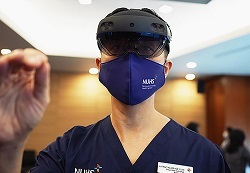
12 August 2021 - This is what happens during a typical brain surgery.
On a computer screen, the surgeon pulls up an image of the patient's brain, taken from an earlier CT scan. This image is an important reference for the surgeon to navigate the far reaches of the brain during an operation - for instance, in search of a tumour.
These neuro-navigational systems have been around for years, helping the surgeon locate the tumour by adjusting the perspective of the brain scan, or zooming in on a particular section. But there are still several disadvantages, said Associate Professor Yeo Tseng Tsai, Head and Senior Consultant at the Division of Neurosurgery, National University Hospital - NUH.
"Firstly, it's a 2D projection of an image," he explained. "We have to constantly change our focus between the patient and a computer screen, which is a distance away." He added that the need to constantly use a computer in the middle of the surgery could also compromise the sterility of the operating theatre environment.
The entry of holographic technology aims to solve both these problems and more. In collaboration with Microsoft and German software developer ApoQlar, NUHS has embarked on a research and development programme to explore the use of mixed reality (MR) technology - a cutting-edge amalgam of virtual and augmented reality – in clinical care.
As part of this programme, neurosurgeons in NUHS are assessing the use of MR to help locate brain tumours while operating on patients, instead of via the conventional neuro-navigational systems, which can be distracting and inconvenient.
Under the MR-augmented approach, surgeons wear holographic visors - second-generation devices developed by Microsoft, dubbed the HoloLens 2 - which they can use to superimpose the brain scans directly over the patient's head.
"With the HoloLens, you're looking right through the skull, the brain, the skin…you can see right where the tumours are, and know where to make the incision. So it's much more intuitive for the neurosurgeon," explained A/Prof Yeo.
So far, between 10 and 15 surgeries have been carried out with the technology.
In addition to helping surgeons in the operating theatre, the technology could also be useful in a variety of other areas in healthcare, from undergraduate and patient education to home-based care. For instance, in the Yong Loo Lin School of Medicine at NUS, MR is being introduced into undergraduate teaching, in hopes of offering students a more engaging and comprehensive experience.
The team also hopes that the holographic visor, which weighs around 500 grams and can be set up in just 10 minutes, could eventually prove a lower-cost, more compact, and more sterile alternative to bulky and expensive operation theatre equipment.
This could be useful not just in Singapore, but also in developing countries which may not be able to afford conventional neuro-navigational systems, which are very expensive.
While the technology holds much potential, more research still has to be carried out before it can be introduced into regular clinical use. One challenge, the team noted, is that the technology is very data-intensive, meaning that bandwidth could prove a problem.
"So we're actively looking at integrating the HoloLens with 5G, in order to boost the data transmission speed and make the whole system a lot smoother than this," said Dr Gao Yujia, the programme lead for holomedicine at NUHS.
"We're also doing our research to ensure that the deployment of these tools is safe, and that we can bring this technology to our doctors, nurses, and ultimately benefit the patients."
Related:
















